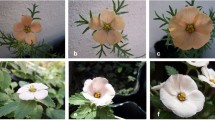Abstract
The genomic evolution of triploid plants with regular bivalent formation is discussed. The conclusion is reached that although all the progeny of an originally triploid individual will be triploid numerically, only part of the progeny will be triploid genomically. The consequences of this for triploid identification by means of chromosome morphology and isozyme numbers is discussed.
Similar content being viewed by others
References
Bolliger, M., 1982: Die GattungPulmonaria in Westeuropa. — Vaduz: Cramer.
Chyi, Y. S., Weeden, N. F., 1984: Relative isozyme band intensities permit the identification of the 2n gamete parent of triploid apple cultivars. — HortScience19: 818–819.
Gottlieb, L. D., 1981: Electrophoresis and plant populations. — Progr. Phytochemistry7: 1–46.
Gottschalk, W., 1976: Die Bedeutung der Polyploidie für die Evolution der Pflanzen. — Stuttgart: G. Fischer.
Grover, I. S., Malik, C. P., 1969: Karyological studies in somePapaver species. — Genet. Iberica21: 105–113.
Hammer, K., Fritsch, R., 1977: Zur Frage nach der Ursprungsart des Kulturmohns (Papaver somniferum L.). — Kulturpflanze25: 113–124.
Hrishi, N. J., 1952: Studies on the cytogenetics of six species ofPennisetum and their comparative morphology and anatomy. — Genetica26: 280–356.
, 1960: Cytogenetical studies onPapaver somniferum L. andP. setigerum Dc. and their hybrids. — Genetica31: 1–130.
Kadereit, J. W., 1986:Papaver somniferum L. (Papaveraceae): a triploid hybrid? — Bot. Jahrb. Syst.106: 221–244.
, 1987a: Experimental evidence on the affinities ofPapaver somniferum (Papaveraceae). — Pl. Syst. Evol.156: 189–195.
, 1987b: Triploidy in the generaPapayer L.,Roemeria Medik. andMeconopsis Vig. (Papaveraceae). — InGreuter, W., Zimmer, B., Behnke, H.-D., (Eds.): Abstracts. XIV International Botanical Congress, Berlin.
Kaur, A., Ha, C. O., Jong, K., Sands, V. E., Chan, H. T., Soepadmo, E., Ashton, P. S., 1978: Apomixis may be widespread among trees of the climax rain forest. — Nature271: 440–442.
Morawetz, W., 1986: Remarks on karyological differentiation patterns in tropical woody plants. — Pl. Syst. Evol.152: 49–100.
Roose, M. L., Gottlieb, L. D., 1976: Genetic and biochemical consequences of polyploidy inTragopogon. — Evolution30: 818–830.
Smith-White, S., 1955: The life history and gametic system ofLeucopogon juniperinus. — Heredity9: 79–91.
Sree Rangasamy, S. R., 1972: Cytogenetical studies on diploid and polyploid taxa of the genusPennisetum Rich. — Genetica43: 257–273.
Yasui, K., 1940: Cytogenetic studies in artificially raised interspecific hybrids ofPapaver. IX. On the bivalents-association in the meiosis of the PMC ofPapaver somniferum. — Cytologia10: 551–557.
Author information
Authors and Affiliations
Rights and permissions
About this article
Cite this article
Kadereit, J.W. A note on the genomic consequences of regular bivalent formation and continued fertility in triploids. Pl Syst Evol 175, 93–99 (1991). https://doi.org/10.1007/BF00942148
Received:
Revised:
Accepted:
Issue Date:
DOI: https://doi.org/10.1007/BF00942148



